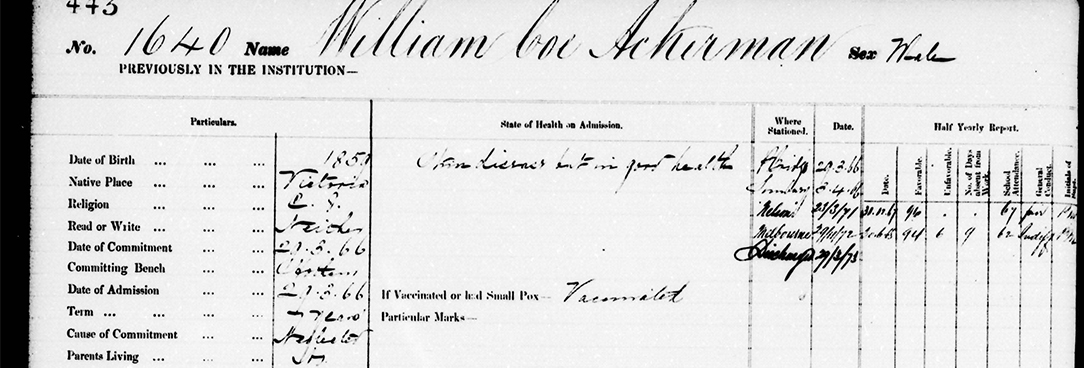Last updated:
What do I need to know?
Are you looking for Victorian records that are less than 99 years old, about yourself or a family member? Read our Guide to accessing Victorian Child Welfare and Adoption Records.
Are you looking for Victorian historic records that are more than 99 years old? Public Record Office Victoria could help you. Please see next steps below.
The Find and Connect glossary states that 'state ward' has been used to describe individuals who experienced institutional or out-of-home ‘care’ as children whilst under the guardianship of a State child welfare authority. Ward of the state records are closed to public access for a period of 99 years from their creation to protect the privacy of the individuals concerned. If you are seeking access to your own ward of the state records, or someone else’s when the records would be less than 99 years old, view the Guide to accessing Victorian Child Welfare and Adoption Records.
This page is about records called the 'Children’s Registers' or 'Ward Registers' – over 100 large volumes, containing one page (or sometimes a half page) about each ward of the state. The green box on the right hand side of this page describes what you can find in these registers.
For the period where the records are open to the public (that is, for wards of the state registered more than 99 years ago), the registers are the only substantial record which still exists about each child (research has shown that in addition to the Children's / Wards Registers, case files were also created in this period, but the files were destroyed in the decades prior to the creation of PROV in 1973. Full details about the destruction of these case files can be found in the article 'Convicted and Neglected' which was published in Provenance journal in 2013 ).
The registers contain the names of some institutions still in operation, which might have preserved historic records about individuals. Go to our services page to seek further assistance.
How do I search?
The records for the period 6 December 1864 to 12 October 1923, have all been digitised and individual children can be found by typing their names into the search form below. Use the 'date' fields to narrow the list if you are searching for a commonly used name.
We digitise and index registers after they are made open at the start of each year. Currently there are five volumes covering the period 1923-1925 which are in the process of being digitised and/or indexed. Digital copies of the volumes covering this period will be progressively made available on the catalogue and then will be made name searchable shortly thereafter.
About these records
These registers list children (aged up to 15 between 1864-1887 and up to 17 from 1887) committed to the care of the State. Although this function of government commenced in 1864, the term 'ward' to collectively describe these children dates only from 1887.
Orders to commit children to State care were made by a court, for one of two general reasons:
- The court believed action was required to care and protect the well-being of the child. Until 1 September 1955 the majority of such children were deemed under the legislation of the era to be 'neglected'. Recent changes to the Children, Youth and Families Act 2005 (Vic) now ensure that historical care and protection orders are not treated as criminal convictions or findings of guilt in any circumstances - further details on this subject can be found on in a blog post on the Find and Connect website.
- The court found the child guilty of an offence punishable with a form of incarceration (see link above).
The registers are a central departmental record detailing each child committed to State ‘care’, why and for how long a child was made a ward of the state and where they were placed during that term.
Who created these records?
The agencies that have created these records over the years are as follows:
- Department of Industrial and Reformatory Schools, 1864-1887 (VA 1466)
- Department of Reformatory Schools, Chief Secretary’s Department, 1887-1954
- Children’s Welfare Department (previously the Department of Neglected Children 1887-1924), Chief Secretary’s Department, 1887-1960 (VA 1467)
- Social Welfare Branch, Chief Secretary’s Department, 1960-1965 (VA 2784)
What are in these records?
Language warning
The language used in this records can be distressing or offensive. It reflect the attitudes of the time and PROV does not endorse these attitudes.
The ward registers might record:
- name
- sex
- date of birth
- birth place
- religion
- ability to read or write
- cause of admission to State care
- dates of admission to State care
- the court which ordered the child to State care
- term (length of time to be in State care)
- details of parents and other family members (if known)
- vaccination details (if known)
- where stationed (location and date of placements in government or government approved private institutions)
- if ‘licensed’ or ‘boarded out’ (dates and location of placements of children made with named, approved individuals within the community)
From late 1880 children in State care for their protection were mostly placed with approved private individuals within the community through ‘licensing’ / apprenticeship or ‘boarding out’ arrangements. Formal State organised adoptions of wards of the state commenced when the Adoption of Children Act 1928 became law in July 1929.
Support for your search
If you are a care leaver or the descendant of a care leaver there are some organisations you can contact for advice and help in your research different services cater for different circumstances. view the Guide to accessing Victorian Child Welfare and Adoption Records for more details.
